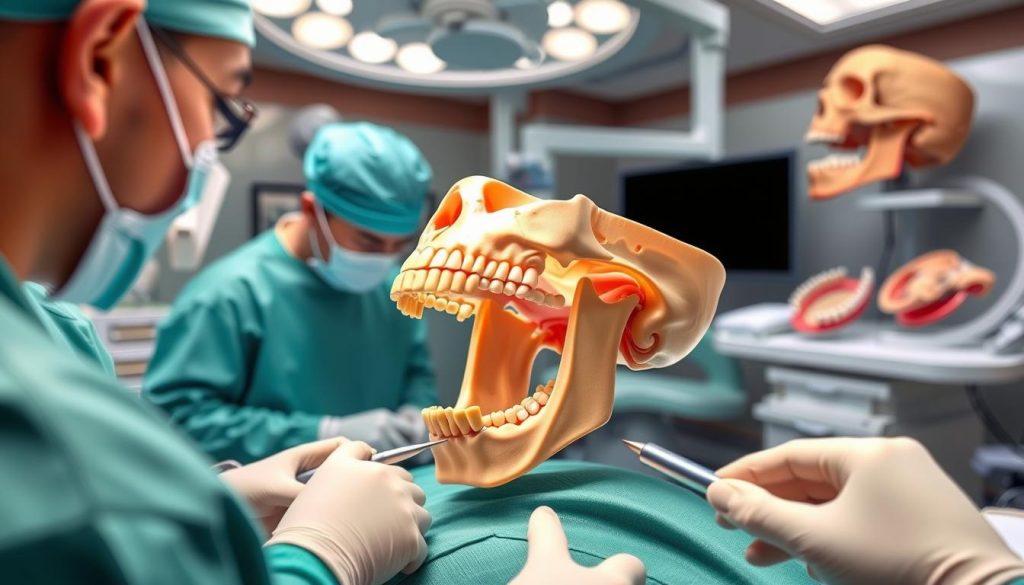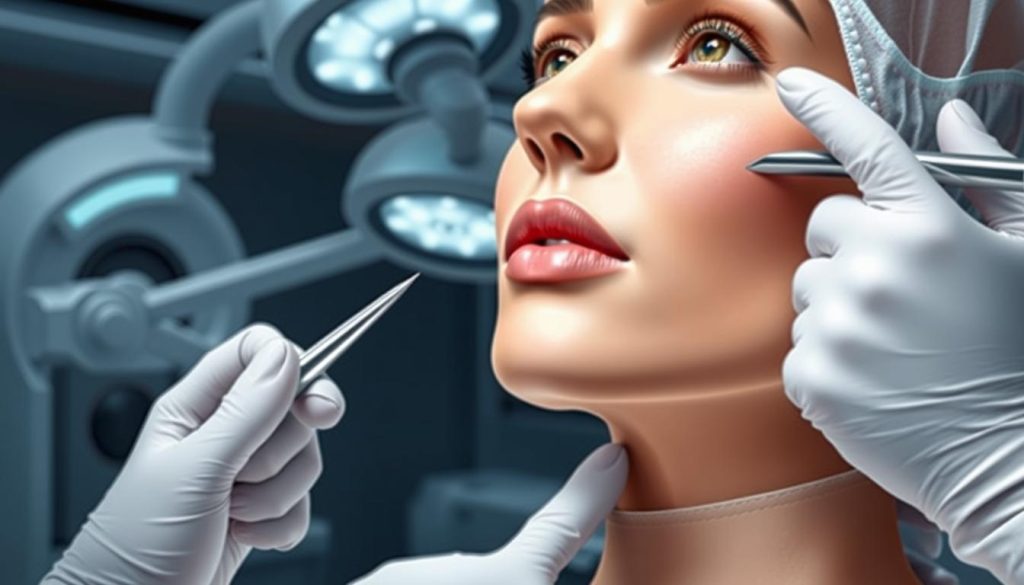Mandible surgery is a key part of maxillofacial procedures. It focuses on fixing the jaw and teeth. Orthognathic surgery, a type of mandible surgery, aims to align the jaws and teeth better.
People might need mandible surgery for many reasons. These include birth defects, injuries, or jaw irregularities. The surgery can improve breathing, speaking, and eating. It also makes the face look better.
Recovery from mandible surgery depends on the case. Most people can go back to normal in a few weeks. The surgery can make biting better, reduce pain, and boost confidence. With new medical technology, mandible surgery is getting more precise and effective.
Understanding Mandible Surgery: A Comprehensive Overview
Mandible surgery is a complex medical procedure. It aims to fix issues with the lower jaw. This surgery can solve problems like bite misalignment and facial asymmetry. Let’s dive into the main points of this detailed procedure.
Defining Mandibular Procedures
Mandibular procedures involve surgery on the lower jaw bone. These operations can change, move, or rebuild the mandible. This improves both function and looks. Common steps include cutting and moving the bone and adding bone grafts to the jaw.
Anatomical Considerations
The mandible is key to facial structure and mouth function. It connects to the skull at the TMJ and holds the lower teeth. Surgeons must carefully work around nerves, blood vessels, and muscles during surgery. Knowing these complex relationships is key for success.
Role of Maxillofacial Surgeons
Maxillofacial surgeons are experts in both dentistry and medicine. They know a lot about facial anatomy and surgery. These specialists plan and do corrective jaw surgery. They work with orthodontists and others to give the best care. Their skills are vital for great results in mandible surgery.
“Maxillofacial surgery requires a deep understanding of both form and function. Our goal is to improve patients’ quality of life through precise surgical interventions.”
Common Conditions Requiring Jaw Surgery
Orthognathic surgery, also known as corrective jaw surgery, fixes many jaw and facial issues. These problems can really affect someone’s life, making surgery a necessary option.
Severe malocclusion is a big issue that surgery can fix. This includes overbites, underbites, and crossbites. People with these problems often have trouble chewing, speaking, and may have constant jaw pain.
Sleep apnea, a serious sleep disorder, can also be treated with jaw surgery. By moving the jaw, surgeons can widen the airway. This helps ease symptoms and improves sleep.
TMJ disorders are another condition that might need surgery. Severe TMJ problems can cause ongoing pain, limited jaw movement, and even lockjaw.
- Facial asymmetry
- Congenital defects
- Jaw injuries
- Difficulty swallowing or breathing
These issues can also be fixed with jaw surgery. The goal is to improve jaw function and look. This makes patients feel better overall.
“Orthognathic surgery can be life-changing for patients with severe jaw misalignments, improving both function and appearance.”
It’s important to know about these conditions before getting jaw surgery. A maxillofacial surgeon can check if surgery is right for you.
Types of Orthognathic Surgery Procedures
Orthognathic surgery offers several techniques to correct jaw misalignments and facial irregularities. Each procedure targets specific issues, providing tailored solutions for patients. Let’s explore three common types of osteotomy procedures used in jaw correction.
Bilateral Sagittal Split Osteotomy
This osteotomy technique is used to adjust the lower jaw position. Surgeons make cuts on both sides of the jaw, allowing for precise movement. It’s ideal for correcting underbites, overbites, and asymmetry issues.
Vertical Ramus Osteotomy
Vertical ramus osteotomy involves cutting the back part of the jaw vertically. This method is effective for moving the lower jaw backward to fix severe overbites. It’s less commonly used but can be beneficial in specific cases.
Inverted L Osteotomy
The inverted L osteotomy is a versatile technique. It allows surgeons to move the jaw in multiple directions. This procedure is helpful in complex cases where both vertical and horizontal adjustments are needed.
| Procedure | Primary Use | Jaw Movement |
|---|---|---|
| Bilateral Sagittal Split Osteotomy | Lower jaw correction | Forward, backward, rotation |
| Vertical Ramus Osteotomy | Severe overbite correction | Backward |
| Inverted L Osteotomy | Complex jaw adjustments | Multiple directions |
Each orthognathic surgery procedure has its unique benefits and applications. The choice depends on the patient’s specific needs and the surgeon’s expertise. Understanding these options helps patients make informed decisions about their jaw correction journey.
Facial Bone Contouring and Aesthetic Enhancement
Facial bone contouring is a key part of jaw reconstruction that changes how you look. It shapes facial bones to make your face look more balanced. Many people get this surgery to feel better about themselves.
Surgeons can shape the mandible during jaw reconstruction. They might make some parts smaller or bigger. The aim is to make your face look more even and attractive.
Common areas targeted in facial bone contouring include:
- Jawline refinement
- Cheekbone enhancement
- Chin reshaping
- Nose bridge adjustment
People often feel much better after this surgery. They feel more confident and sure of themselves. Their new look makes them feel more like themselves.
“The transformation I experienced through facial bone contouring was life-changing. It not only improved my appearance but also boosted my confidence in ways I never imagined.”
New technology has made facial bone contouring better. Surgeons can now plan surgeries very carefully. This makes sure the results are just right for each person.
TMJ Surgery and Joint Reconstruction
TMJ surgery fixes problems with the temporomandibular joint. This joint connects the jawbone to the skull. People with severe pain or limited jaw movement might find relief through these surgeries.
Jaw reconstruction has improved a lot. Now, it offers hope to those with TMJ disorders.

Arthroplasty Procedures
Arthroplasty is a common TMJ surgery. It reshapes or repairs the joint. This can help reduce pain and improve jaw function.
Surgeons might remove damaged tissue or move the disc in the joint. Recovery times vary. But, many patients see a big improvement in their life quality.
Joint Replacement Options
In severe cases, total joint replacement is needed. This surgery replaces the whole joint with artificial parts. These parts are made of medical-grade plastics and metals.
This option is more invasive. But, it can offer lasting relief for those with serious joint damage.
Minimally Invasive Techniques
New advancements have led to less invasive TMJ surgeries. Arthroscopy uses small cuts and a tiny camera to diagnose and treat issues. This method often means quicker recovery and less discomfort after surgery.
Many patients choose these options because of less scarring and faster healing.
- Shorter hospital stays
- Less visible scarring
- Faster return to normal activities
TMJ surgery and jaw reconstruction keep getting better. They offer hope to those with chronic jaw pain and dysfunction. Talking to a skilled maxillofacial surgeon is key to finding the right treatment.
Genioplasty: Chin Enhancement and Reconstruction
Genioplasty is a special surgery that shapes the chin. It can greatly improve how balanced and profiled your face looks. Surgeons might do this surgery alone or with other jaw surgeries for a complete look.
Surgeons can move the chin in different ways during genioplasty. They might add implants or take away bone to get the right shape. The aim is to make your chin look natural and fit well with your other facial features.
People get genioplasty for many reasons. Some want a stronger or more forward chin. Others want a smaller chin. It can also help with eating or breathing problems.
| Genioplasty Type | Description | Recovery Time |
|---|---|---|
| Sliding Genioplasty | Cuts and repositions chin bone | 4-6 weeks |
| Chin Implants | Adds synthetic material to enhance chin | 2-3 weeks |
| Reduction Genioplasty | Removes excess bone to reduce chin size | 3-4 weeks |
How long it takes to recover from genioplasty depends on the method used. Most people can go back to their usual activities in a few weeks. It can take months for the full effects of the surgery to show as swelling goes down and tissues settle.
Distraction Osteogenesis in Jaw Reconstruction
Distraction osteogenesis is a new way to rebuild the jaw. It makes bones grow longer, which is better than old surgery methods.
Progressive Bone Lengthening
Surgeons cut the jawbone in distraction osteogenesis. Then, they use a special tool to slowly move the bone parts apart. This makes new bone grow, filling the gap and making the jaw longer.
Treatment Timeline
The treatment with distraction osteogenesis takes months. Here’s what happens:
| Stage | Duration | Description |
|---|---|---|
| Initial Surgery | 1 day | Surgeons cut the bone and place the distraction device |
| Latency Period | 5-7 days | Healing starts, no device use |
| Distraction Phase | 1-2 weeks | Daily adjustments to move bone segments |
| Consolidation Phase | 6-12 weeks | New bone gets stronger |
| Device Removal | 1 day | Outpatient surgery to remove the device |
Applications in Pediatric Cases
Distraction osteogenesis is great for kids needing jaw fixes. It lets bones grow slowly, fitting the child’s face as it grows. This method fixes big underbites, small jaws, and birth defects with less surgery and quicker healing.
Pre-operative Planning and Consultation
Getting ready for mandible surgery means careful planning and talking with your maxillofacial surgery team. This makes sure you get the best results from your surgery.
Your journey starts with a first meeting. Here, your surgeon will look at your jaw, talk about what you want, and explain how the surgery works. They might also ask for tests to learn more about your situation.
Tests you might get include:
- X-rays and 3D imaging scans
- Dental impressions
- Blood tests
- Physical examination
These tests help your surgeon make a detailed plan just for you. They use this info to figure out what surgery you need and what to expect.
“Clear communication between patient and surgeon is key to achieving the desired results in mandible surgery.”
When you talk to your surgeon, ask any questions or share your worries. It’s important to understand and feel comfortable with the surgery for it to go well.
| Pre-operative Step | Purpose |
|---|---|
| Initial Consultation | Assess jaw structure and discuss goals |
| Imaging Tests | Create detailed surgical plan |
| Physical Exam | Evaluate overall health for surgery |
| Follow-up Consultations | Address concerns and finalize plans |
Remember, good planning before surgery is key for success. Your maxillofacial surgery team will help you through every step. They make sure you’re ready for what’s coming.
Advanced Imaging and Surgical Planning Technology
New technologies have changed orthognathic surgery and maxillofacial procedures. These advancements help surgeons plan and do complex jaw surgeries with great precision. Let’s look at the main improvements making mandible surgeries better.
3D Scanning Applications
3D scanning gives detailed views of a patient’s face. It takes precise measurements. This lets surgeons make accurate models for planning orthognathic surgery.
The scans show challenges and help make decisions during surgery.
Virtual Surgical Planning
Virtual planning tools let maxillofacial surgeons try different surgical approaches. They can see how things will look and change plans before surgery. This makes talking to patients easier and improves surgery results.
Computer-Aided Design
Computer-aided design (CAD) software is key in planning orthognathic surgery. It helps make custom surgical guides and implants for each patient. This makes surgery better and shorter.
| Technology | Benefits | Applications |
|---|---|---|
| 3D Scanning | Accurate measurements, detailed facial mapping | Pre-surgical planning, patient education |
| Virtual Planning | Outcome simulation, improved surgical precision | Complex jaw reconstructions, bite corrections |
| CAD Software | Custom surgical guides, personalized implants | Facial asymmetry correction, TMJ replacements |
These advanced technologies have greatly improved maxillofacial surgery. They give surgeons powerful tools for planning and doing complex surgeries with more accuracy and confidence.
Post-operative Recovery Timeline
Recovery from mandible surgery is a carefully managed process. Patients need to know the healing stages and what to expect. Let’s look at the recovery timeline and the steps for healing.
Immediate Recovery Phase
The first few days after surgery are key. Patients usually stay in the hospital for 1-3 days. Medical staff watch their vital signs and manage pain.
Swelling peaks around day 3 and starts to go down after a week. Ice packs and medicines help with pain and swelling.
Long-term Healing Process
Full recovery from jaw reconstruction takes several months. Patients slowly get back to normal activities in 6-8 weeks. Bone healing takes up to a year.
Diet changes from liquids to soft foods, and then to regular eating in 6-8 weeks.
| Recovery Stage | Timeline | Key Points |
|---|---|---|
| Immediate | 1-3 days | Hospital stay, pain management |
| Early | 1-2 weeks | Home rest, liquid diet |
| Intermediate | 2-6 weeks | Soft foods, return to light activities |
| Long-term | 6+ months | Gradual return to normal diet and activities |
Physical Therapy Requirements
Physical therapy is key in mandible surgery recovery. Jaw exercises start 1-2 weeks after surgery. They help prevent stiffness.
As healing gets better, exercises get more intense. This improves jaw movement and strengthens muscles.
Patients must follow their surgeon’s instructions and go to all follow-up appointments. This ensures proper healing and the best results from jaw reconstruction.
Dietary Considerations During Recovery
After mandible or orthognathic surgery, patients face special dietary challenges. They need to choose foods carefully to get the right nutrition without hurting the healing area.
In the early stages, a liquid diet is key. Patients usually eat:
- Smoothies
- Protein shakes
- Clear broths
- Meal replacement drinks
As they heal, soft foods become easier to eat. These include:
- Mashed potatoes
- Yogurt
- Pureed vegetables
- Soft-cooked eggs
Over time, they can go back to eating regular food. This can take weeks or months, depending on how fast they heal and the type of surgery.
“Proper nutrition is key to optimal healing after orthognathic surgery. Patients should follow their surgeon’s dietary guidelines closely to support recovery and avoid complications.”
It’s important to get enough protein for healing. Patients can increase protein by:
- Adding protein powder to smoothies
- Incorporating Greek yogurt into meals
- Eating soft-cooked lean meats when the surgeon says it’s okay
Drinking plenty of water is also vital. Patients should drink water often, using a straw if their doctor says it’s okay.
Following these dietary tips helps patients recover well and get the best results from their surgery.
Potential Risks and Complications
Mandible surgery is a complex procedure. It carries risks that patients should know about. Being aware of common side effects and warning signs helps ensure a smooth recovery.
Common Side Effects
Patients often face swelling, bruising, and numbness after surgery. These usually go away in weeks. They might also find it hard to speak and eat at first.
Warning Signs
Though rare, serious complications can happen. Watch out for:
- Severe pain that doesn’t go away with medicine
- Too much bleeding
- Signs of infection like fever, redness, and warmth
- Difficulty breathing
- Sudden changes in how your teeth fit together
Emergency Care Guidelines
Get help right away if you notice:
- Uncontrolled bleeding
- Severe swelling that makes it hard to breathe
- A high fever (over 101°F)
- Persistent nausea or vomiting
If you see these signs, call your maxillofacial surgeon or go to the emergency room. Quick action can prevent serious problems and help you recover well from mandible surgery.
Benefits and Expected Outcomes
Mandible surgery can change lives for many. It fixes jaw issues, making eating and speaking easier. It also helps with breathing, which is great for those with sleep apnea.
It also makes faces look better. Surgery can make features more balanced, leading to a more even look. This can make people feel more confident and happy.
- Improved bite alignment
- Enhanced speech and breathing
- Balanced facial appearance
- Increased self-confidence
But, it’s important to know what to expect. Results can differ for everyone. Jaw surgery is big, and recovery takes time. Being patient is key to the best results.
“Mandible surgery transformed my life. Not only can I eat and speak more comfortably, but I feel so much more confident in my appearance.”
Talk to your surgeon about what you hope to get from surgery. They can give you a clear idea of what’s possible for you. This helps you understand the good and bad sides of the surgery.
Insurance Coverage and Financial Planning
Understanding the financial side of mandible surgery is key for those thinking about orthognathic procedures. The costs can vary a lot. This depends on how complex the surgery is and what each patient needs.
Cost Considerations
The costs of mandible surgery include surgeon fees, anesthesia, hospital charges, and care after surgery. Prices can go from $20,000 to $40,000 or more for more complex cases. It’s vital to get a detailed breakdown from your surgeon’s office.
Insurance Requirements
Many insurance plans cover orthognathic surgery if it’s medically necessary. Patients often need to show proof of functional issues, like trouble chewing or breathing problems. Getting pre-authorization is usually needed, and it can take several weeks.
Payment Options
For those without full insurance coverage, there are several payment options:
- Medical credit cards
- Hospital payment plans
- Health savings accounts (HSAs)
- Personal loans
Some surgical centers offer in-house financing options. It’s wise to talk about these with your provider’s financial counselor. Remember, investing in mandible surgery can greatly improve your oral function and overall quality of life.
Long-term Care and Maintenance
After jaw reconstruction or maxillofacial surgery, patients must commit to long-term care. This care is key to the success of their surgery and keeping their new facial look. Regular check-ups with the surgeon are very important in the months and years after surgery.
Patients need to follow a strict oral hygiene routine to avoid infections and problems. This includes gentle brushing, flossing, and using mouthwashes as prescribed. Some might need to change their diet or lifestyle to protect their jaw reconstruction results.
Often, physical therapy exercises are needed long after the initial recovery. These exercises help keep the jaw mobile and strong. Patients should tell their maxillofacial surgeon about any unusual symptoms or discomfort right away. This helps catch and fix problems early.
By following post-operative instructions and keeping good overall health, patients can enjoy their jaw reconstruction for years. Regular dental visits and proper care are essential to keep the results of maxillofacial surgery lasting.
FAQ
Q: What is mandible surgery?
A: Mandible surgery reshapes or repositions the lower jaw. It fixes issues with bite, jaw function, and facial look. It also helps with breathing problems.
Q: Who typically needs mandible surgery?
A: People with severe bites, TMJ disorders, sleep apnea, or facial imbalance might need it. It’s also for those wanting to improve their jaw line and facial profile.
Q: What are the different types of mandible surgery?
A: There are several types, like Bilateral Sagittal Split Osteotomy (BSSO) and Vertical Ramus Osteotomy. Genioplasty (chin surgery) and TMJ surgery are also common. The right one depends on the patient’s needs.
Q: How long does recovery from mandible surgery typically take?
A: Recovery time is 2-4 weeks off work or school. Swelling and discomfort lessen in the first few weeks. Full healing and results take months to a year.
Q: What are the possible risks and complications of mandible surgery?
A: Risks include infection, bleeding, nerve damage, and changes in sensation. Bite misalignment and TMJ issues are also possible. But, serious problems are rare with an experienced surgeon.
Q: How is mandible surgery planned?
A: Planning involves consultations, exams, 3D imaging, and virtual planning. Advanced tech helps create precise, personalized plans.
Q: What dietary restrictions are there after mandible surgery?
A: Patients start with a liquid diet, then move to soft foods. Returning to normal diet takes 6-8 weeks or more.
Q: Is mandible surgery covered by insurance?
A: Coverage varies. Necessary procedures are more likely to be covered. Check with your insurance and surgeon for details.
Q: What is distraction osteogenesis?
A: It’s a method to lengthen bone in jaw reconstruction. It’s useful in kids and promotes growth with less surgery.
Q: How can mandible surgery improve sleep apnea?
A: Surgery can treat sleep apnea by adjusting the jaw. This opens the airway, improving breathing and sleep quality.


















